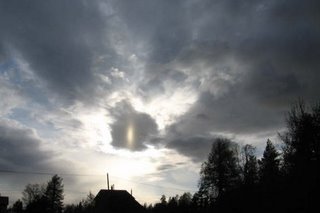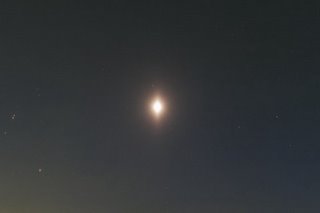 |
| From The Graphic Collection of the Hungarian National Museum. MTKcs.9613.T. and MTKcs.9612.T. Reproduced with permission. |
On 3 August 1664, a curious phenomenon made the inhabitants of Pápa, Hungary wonder. Between 11 and 12 pm a shining white cross appeared in the sky together with the crescent Moon. They seemed to be fighting for about an hour, either the one or the other overcoming, but by midnight the Moon had deferred to the cross, which – according to the contemporary description – might be a good omen.
Two anonymous engravings eternalised the apparition,
both from the late 17th century. They are part of The Graphic Collection of the
Hungarian National Museum, a collection which also contains a few etchings depicting
historical halo observations. These have earlier been dealt with in a Hungarian
language article [Farkas A., Kiricsi Á., Klemm L. (2011) „(R)égi csodajelek, 17-18. századi halójelenségek a Magyar Nemzeti
Múzeumból”. Fizikai Szemle 61 (12):
407-413.], and are going to serve as the basis for the next historical mini-series
of The Halo Vault.
Of course, we cannot say with certainty what the 17th
century inhabitants of Pápa saw exactly, but presumably it was a halo phenomenon.
The description might indicate a lunar pillar with a stretch of a cloud, or
even a pillar with upper tangent-arc. The time given in the contemporary
accounts is rather problematic, however. The Moon was almost full and already
21° high in the sky at 11 pm, so the implied lunar pillar can certainly be ruled out. But if we
continue theorizing, and suppose that the date given is still according to the
Julian Calendar, the idea of a pillar is much more likely, as the Moon in the given
time-slot was between -3,5° and 6° (though not in such a thin crescent shape as in
the images). In Hungary the Georgian Calendar had been in use for almost 80
years in 1664; but we know that at least one of the two engravings is by a
German master, and in the Protestant areas of Germany the adoption of the
calendar reform was much slower. In some parts the reform was only enacted in the
18th century. But again, this is only a hypothesis, we cannot fully decipher the two images and their descriptions.
The heavenly cross appearing in the sky was considered
a mysterious sign, and as usual with such unaccountable phenomena, reports
tried to authenticate it in various ways. As we learn from the text below one
of the engravings, the cross was not only visible in Pápa, but also some 120 kms
away, near Vienna, the seat of the Habsburg monarchy. The other document
mentions that even soldiers witnessed it, thus giving the account more credit.
The cross subjugating the Moon could easily be
considered a good sign in 17th century Hungary. Most of the country at that
time was under Ottoman Rule, and the Christian cross overcoming the traditional
Muslim symbol of the crescent must have been thought by many as a symbol of
divine providence against the Turks.
By Ágnes Kiricsi



